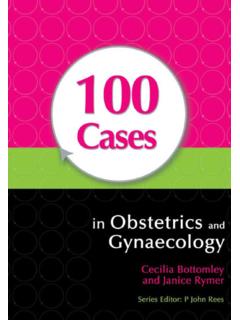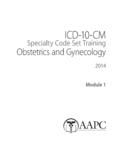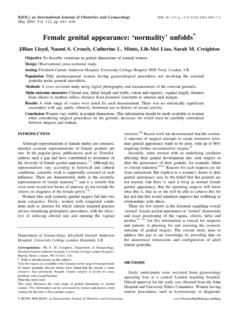Transcription of Misoprostol in obstetrics and gynecology
1 INTRODUCTIONM isoprostol in obstetrics and gynecologyAlthough Misoprostol is generally not registered for repro-ductive health use, it is widely used by gynecologists andobstetricians. In a survey on the use of Misoprostol con-ducted in three contrasting countries (Brazil, Jamaica andthe USA), 61% of obstetricians and gynecologists stated thatthey used it to evacuate the uterus after intrauterine fetaldeath, 57% used it for missed abortions, and 46% to inducelabor[1]. Its popularity may be accounted for by the fact thatit is as effective as the best available prostaglandin at soft-ening the cervix and producing contractions of the uterus,while at the same time being low-cost and absence of registration for its obstetrical and gyne-cological applications is an important problem. The pharma-ceutical industry is normallyresponsible for informingphysicians about drugs' indications, effectiveness, correctdosages, route of administration, dosage interval, contra-indications, precautions, side-effects and management ofcomplications.
2 However, as Misoprostol is generally not re-gistered for reproductive health indications, the industry hasneither provided this information for physicians nor pack-aged the drug in appropriate dosages. The result is that thisdrug is used in many different ways according to informallocal protocols. While this may not be a serious problem inearly pregnancy, the use of too high a dose in late pregnancycan have serious consequences. In induction of labor, forexample, too high a dose of Misoprostol may cause uterinehyperstimulation and rupture of the uterus, thus jeopardiz-ing the life of the mother and of the fetus[2 4]. Misoprostol is an analogue of prostaglandin E1 (PG E1)which was registered in many countries during the secondhalf of the 1980s under the proprietary name Cytotec(Pharmacia), for the treatment of peptic ulcers, particularlythose caused by non-steroidal anti-inflammatory drugs[5 7].
3 Its use for this purpose is contraindicated for pregnantwomen as it may cause uterine contractions and Brazil, as in many other countries where abortion isillegal, employees of retail pharmacies are accustomed toselling a wide range of drugs to bring on periods . In the1980s they realized that the uterine side-effect of Cytotecmade it a highly effective drug for bringing on periods incases of delayed menses. The knowledge that misoprostolwas very effective at causing abortions spread rapidly and,by the end of the 1980s, a high proportion of clandestineabortions in Brazil were induced by Misoprostol [8,9]. Similarexperiences have been described in other Latin Americancountries[10]. Misoprostol 's undisputed ability to bring on uterinecontractions led to it being evaluated as a means of inducingabortion or labor with a dead[11,12]or live[13 18]fetus, orto interrupt pregnancy[19 22].
4 Its potential was especiallypromising in the developing world where maternal mortalityis high and where an effective, low-cost and stable prosta-glandin is urgently needed. The benefits of Misoprostol insettings with few resources have since been widely demon-strated. It has been possible to reduce failed inductions andthe proportion of cesarean sections[3,23 28], and it hasfacilitated the difficult challenge of evacuating a dead fetusduring the second trimester of pregnancy, substitutingmethods that carry a high risk of morbidity and mortality[29,30]. It has also proved its capacity to prevent postpartumhemorrhage in situations where oxytocin is not available ormay lose effectiveness due to high ambient temperatures[31,32], and there is also now evidence to correlate theincrease in its use with the reduction of morbidity andmortality associated with abortion in countries with restric-tive laws[10,33 35].
5 In spite of all these advantages, Misoprostol has not beenapproved for use in gynecology or obstetrics in mostcountries. However, there are signs that health regulatorsare embracing the use of Misoprostol . In 2003, the use ofmisoprostol in combination with mifepristone was approvedby the United States Food and Drug Administration for theinduction of abortion[36], and Misoprostol has been addedto the World Health Organization (WHO) Model List ofEssential Drugs for the induction of labor and abortion[37].In 2006, the government of Nigeria registered Misoprostol forthe prevention and treatment of postpartum hemorrhage,and a national distribution program is underway in Ethiopia( ). Furthermore, Pharmacia'sexclusive rights to Misoprostol ran out in 2005, and a numberof generic alternatives to Cytotec are now being 200 g tablets are now produced in France,China, Brazil and Taiwan, and 25 g vaginal pessaries areavailable in Brazil and Egypt ( ).
6 The absence of clear guidance relating to use ofmisoprostol in gynecology and obstetrics has meant thatphysicians and their patients run the risk of inappropriate0020-7292/$ - see front matter 2007 International Federation of gynecology and obstetrics . Published by Elsevier Ireland rights at Journal of gynecology and obstetrics (2007)99, S156 S159use, with potentially severe consequences for both womanand fetus. It also places the attending physicians at risk oflitigation as, in the absence of a license for use in pregnancy,legal liability rests with the Use of drugs other than forapproved indicationsUse of drugs for indications other than those approved ( off-label use) is common practice in obstetrics [38]. In a recentstudy of 17,000 consecutive antenatal prescriptions in a largeUK government hospital, only 1% of drugs were unlicensed[39].
7 However, 75% of all prescriptions were off-label , mostof which would be considered safe for use in pregnancy. Theyincluded betamethasone (for the prevention of respiratorydistress syndrome in premature neonates), erythromycin(for the prevention of chorioamnionitis after ruptured mem-branes) and magnesium sulfate (for eclampsia). Only 10% ofthe drugs prescribed were considered high risk. Off-label therapy is also accepted, for example, by the United StatesFood and Drug Administration, which stated, Good medicalpractice and the best interests of the patient require thatphysicians use legally available to theirbest knowledge and judgment. If physicians use a productfor an indication not in the approved labeling, they have theresponsibility to be well informed about the product, tobase its use on firm scientific rationale and on sound medicalevidence, and to maintain records of the product's use andeffects [40].
8 Our objective in publishing the essential points of ourexisting knowledge about the use of Misoprostol in gynecol-ogy and obstetrics in this supplement is to enable practi-tioners to use the drug safely outside the approvedindications, while beingwell informed about the product,to base its use on firm scientific rationale and on soundmedical evidence. Guidelines for Misoprostol use in repro-ductive health are available in South America[41]and on theinternet ( ) but it is hoped that thissupplement will make knowledge about optimal misoprostoldosages more widely Contents of the supplementThis supplement is designed to provide guidance to help ourfellow gynecologists and obstetricians to take decisions ontreatment for a number of specific conditions. This requiresan evaluation of the evidence and a weighing up of thepotential risks and benefits of the drug's use in each has a large number of potential uses.
9 In thissupplement, a team of experts has assessed the existingevidence and has suggested an optimal dose and route. Inclinical practice, however, it is for each physician to decidehow best to apply it in his or her own practice, depending onthe circumstances of each individual case[42].In an effort to include the different uses of Misoprostol ingynecology and obstetrics , this supplement includes the fol-lowing articles: pharmacokinetics and basic science ; cer-vical priming ; induced abortion in 1st trimester ; induced abortion in 2nd trimester ; incomplete abortion ; missed abortion ; early embryonic loss ; intrauterinefetal death ; induction of labor with a live fetus , andTable 1 Misoprostol dosages for reproductive healthIndicationDosageNotesInduced abortion (0 12 weeks)800 g vaginally 12-hrlyIdeally used 48 h after mifepristone 200 mgMissed abortion (0 12 weeks)Vaginal Misoprostol 800 gstat or sublingual misoprostol600 gLeave to work for 1 2 weeks (unless heavybleeding or infection)Incomplete abortion(0 12 weeks)600 g orally statLeave to work for 2 weeks (unless heavybleeding or infection)Induced abortion (13 24 weeks)400 g vaginally 3-hrlyUse 200 g only in women with cesarean used 48 h after mifepristone 200 mgIntrauterine fetal death(N24 weeks)13 17 weeks: 200 g 6-hrly18 26 weeks: 100 g 6-hrly27 43 wks.
10 25 50 g 4-hrlyReduce doses in women with previous cesareansectionInduction of labour (livefetusN24 weeks)25 g vaginally 4-hrly OR 50 g orally4-hrlyDo not use if previous cesarean sectionPPH prophylaxis600 g orally statNot as effective as oxytocin or second twin before not repeat within 2 hPPH treatment600 g orally statLimited evidence for benefit use conventionaloxytocics firstCervical ripening prior toinstrumentation400 g vaginally 3 h before procedure Use for insertion of intrauterine device, surgicaltermination of pregnancy, dilatation andcurettage, hysteroscopyWallchart with summary of Misoprostol dosages for reproductive health indications (stat = single dose taken immediately, PPH = postpartumhemorrhage) International Journal of gynecology and obstetrics 2007S157 INTRODUCTION prevention and treatment of postpartum hemorrhage .Asummary table of the recommended dosages in each chapteris given inTable concepts are repeated in all articles, such ascontraindications for the use of Misoprostol .










